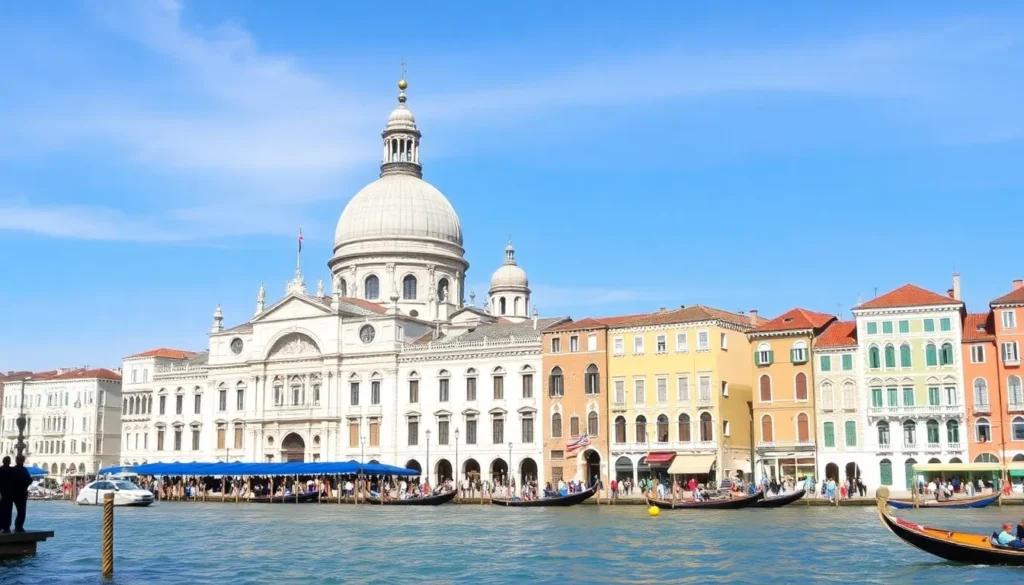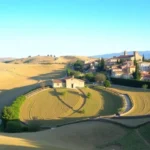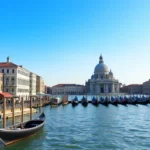20 interesting facts about Venice

- Cicchetti: The Venetian Tapas Experience
- Notable Figures Born in Venice
- Venice’s Fish-like Shape
- Napoleon’s Dislike for the Carnival
- The Bridge of Sighs
- The Rialto Bridge: A Test of Faith
- Unusual Bridge Names
- Swimming Prohibited
- The Acqua Alta Phenomenon
- Gondolas: A Symbol of Venice
- Affordable Gondola Rides
- Why Are Gondolas Black?
- A Song with No Venetian Roots
- A Historical Jewish Ghetto
- The Winged Lion: Venice’s Symbol
- Ciao: More Than Just a Greeting
- Venice’s Unique Streets
- From Fields to Squares
- The Origin of Wine Terms
- Embrace the Night in Venice
Venice, often called the "City of Canals," is a mesmerizing destination that captivates visitors with its rich history, stunning architecture, and unique culture. Each vez que uno visita esta encantadora ciudad, no son solo las vistas impresionantes las que dejan una impresión; siempre hay nuevos y fascinantes hechos que esperar a ser descubiertos. Here, we delve into 20 intriguing curiosities about Venice that will deepen your appreciation for this romantic locale. Si estás buscando información más concisa, echa un vistazo a nuestros 10 facts about Venice o 5 facts about Venice que también ofrecen datos interesantes sobre esta ciudad mágica.
Have you ever wondered about the culinary delights of Venice? Or why the city's gondolas are exclusively black? Explore these and many more captivating tidbits about Venice below.
Cicchetti: The Venetian Tapas Experience
While you might think of Spain when it comes to tapas, Venice has its own delightful version called cicchetti (pronounced “chee-ket-tee”). These small plates can include a variety of offerings:
- Delicious slices of bread topped with cured meats or fish
- Flavorful meatballs
- Petite servings of fresh seafood
Enjoying cicchetti is best complemented by an “ombra,” which is a glass of local wine. For an authentic experience, visit some of the best bacari (tapas bars) scattered throughout the city.
Notable Figures Born in Venice
Venice is the birthplace of several illustrious personalities, including the infamous Giacomo Casanova, known for his romantic escapades. Another remarkable figure is Elena Lucrezia Cornaro Piscopia, the first woman to earn a university degree in the world. Interestingly, many people mistakenly believe that Marco Polo, the renowned explorer, was born here; he actually hails from Corfu, which was part of the Venetian Republic during his time.
Venice’s Fish-like Shape
From an aerial perspective, Venice boasts una forma única que se asemeja a un pez. This striking layout is not just a geographical curiosity but also speaks to the city's historical reliance on the sea and its intricate network of canals, contributing to many interesting facts about Venezia.
Napoleon’s Dislike for the Carnival
The famous Venice Carnival dates back to 1296 and has always been a vibrant celebration. However, during Napoleon's rule, he suppressed the carnival, fearing it could lead to insurrections. Thankfully, the tradition has since been revived, allowing visitors to experience its colorful parades and masked festivities.
The Bridge of Sighs
Often misconceived as a spot for romantic sighs, the Bridge of Sighs actually derives its name from the sighs of prisoners who crossed it, catching their last glimpse of freedom before entering the prison. The bridge's haunting beauty adds an air of melancholy to its history.
The Rialto Bridge: A Test of Faith
When the Rialto Bridge was first proposed, many doubted its feasibility. Skeptics claimed it would collapse before completion, leading to a series of comical threats that were later immortalized in stone. Today, the bridge stands as a testament to Venetian engineering and resilience.
Unusual Bridge Names
Venice is home to some uniquely named bridges, including:
- Ponte delle Tette (the Bridge of Breasts) – once a popular spot for prostitutes.
- Ponte dei Pugni (the Bridge of Fists) – known for its fistfights between rival neighborhoods.
- Ponte Chiodo (Nail Bridge) – a bridge without railings, offering a daring walk.
Swimming Prohibited
Despite its inviting waters, swimming in Venice is illegal, largely to preserve the city's delicate ecosystem. If you're craving a swim, head to the nearby Lido di Venezia, where sun and sand await.
The Acqua Alta Phenomenon
One of Venice's most famous occurrences is the acqua alta, or "high water," which floods parts of the city, including St. Mark's Square, from October to March. This natural phenomenon is a reminder of Venice's precarious relationship with the sea.
Gondolas: A Symbol of Venice
Gondolas are one of Venice's most iconic symbols. Each gondola is meticulously crafted in a traditional workshop known as squero veneziano, utilizando ocho tipos diferentes de madera. They measure 10.85 meters long and 1.4 meters wide, weighing around 350 kg.
Affordable Gondola Rides
While gondola rides can be pricey, there's a budget-friendly option known as the traghetto. These gondolas ferry passengers across the Grand Canal for just €2, making it an excellent way to experience a gondola ride without breaking the bank. Here are some popular traghetto stops:
- Fondamenta Santa Lucia (near the train station)
- Fondamente San Simeón Piccolo
- Campo del Traghetto – Calle Lanza
- San Samuele – Ca’ Rezzónico
- Sant’ Angelo – San Tomá
- Riva del Carbón – Fondamente del Vin
- Santa Sofia – Pescaria
- San Marcuola – Fóndaco dei Turchi
Why Are Gondolas Black?
The iconic black color of gondolas stems from a decree by the Serenissima Republic of Venice, which aimed to minimize competition among the wealthy, who were decorating their gondolas extravagantly. Some say the tradition also began as a symbol of mourning during a plague outbreak.
A Song with No Venetian Roots
One of the most popular songs among gondoliers is “Oh, Sole Mio,” a classic from Naples. Despite its association with Venice, this beloved tune has no Venetian origins, showcasing the blending of Italian culture throughout the country.
A Historical Jewish Ghetto
Venice is home to the world's first ghetto, the Jewish Ghetto, established in the early 16th century. This area, rich in history and culture, is often overlooked by tourists but offers a unique glimpse into the city’s diverse past, adding to the many intriguing facts about Venice.
The Winged Lion: Venice’s Symbol
The winged lion is a prominent symbol of Venice, often depicted holding an open book that reads “PAX TIBI MARCE EVANGELISTA MEVS” (Peace to you, Mark, my evangelist). This inscription honors St. Mark, the city’s patron saint, and appears in various forms throughout the city.
Ciao: More Than Just a Greeting
While “ciao” is widely recognized as a casual greeting in Italian, its roots can be traced back to the Venetian phrase “sciao vostro,” meaning “your slave.” This reflects the historical context of politeness and servitude in Venetian culture.
Venice’s Unique Streets
In Venice, streets are referred to as “calle” rather than the more common “via” found in other Italian cities. A particularmente estrecha calle, “calle Varisco,” measures just 53 cm wide, making it one of the narrowest in the world.
From Fields to Squares
Interestingly, the squares in Venice are known as “campi” (fields), a nod to their past when these open spaces were primarily used for agriculture.
The Origin of Wine Terms
In the Venetian dialect, a glass of wine is called “ombra,” meaning shadow. This term originated from the tradition of wine vendors in Piazza San Marco who followed the shadow of the campanile to keep their wine cool while they sold it.
Embrace the Night in Venice
With its narrow streets and picturesque canals, Venice is often overrun with tourists during the day. To experience the city in a different light, consider visiting in the evening when the crowds have thinned, and the city takes on a magical ambiance.
With so much to discover, Venice never ceases to amaze. If you have your own curiosities about Venice, feel free to share them in the comments below—we’d love to hear your insights! También, no olvides explorar más facts about Venezia que quizás no conocías.
For those planning a visit, consider these travel tips:
| Save on your trip |
| Compare and find cheap flights here |
| Book accommodation at the best prices here |
| Reserve activities and excursions in Spanish here |
| Get a 5% discount on your travel insurance with IATI here |
| Book transfers from the airport here |
| Get a gift of €10 when booking transport across Europe here |
| Find out how to withdraw money without commissions here |
| Get a 5% discount on your eSIM from Holafly here |
| Rent a car at the best offers here |
| Compare prices for van rentals here |
| Discover the best books and travel guides here |
| All our articles about Italy |





Deja una respuesta